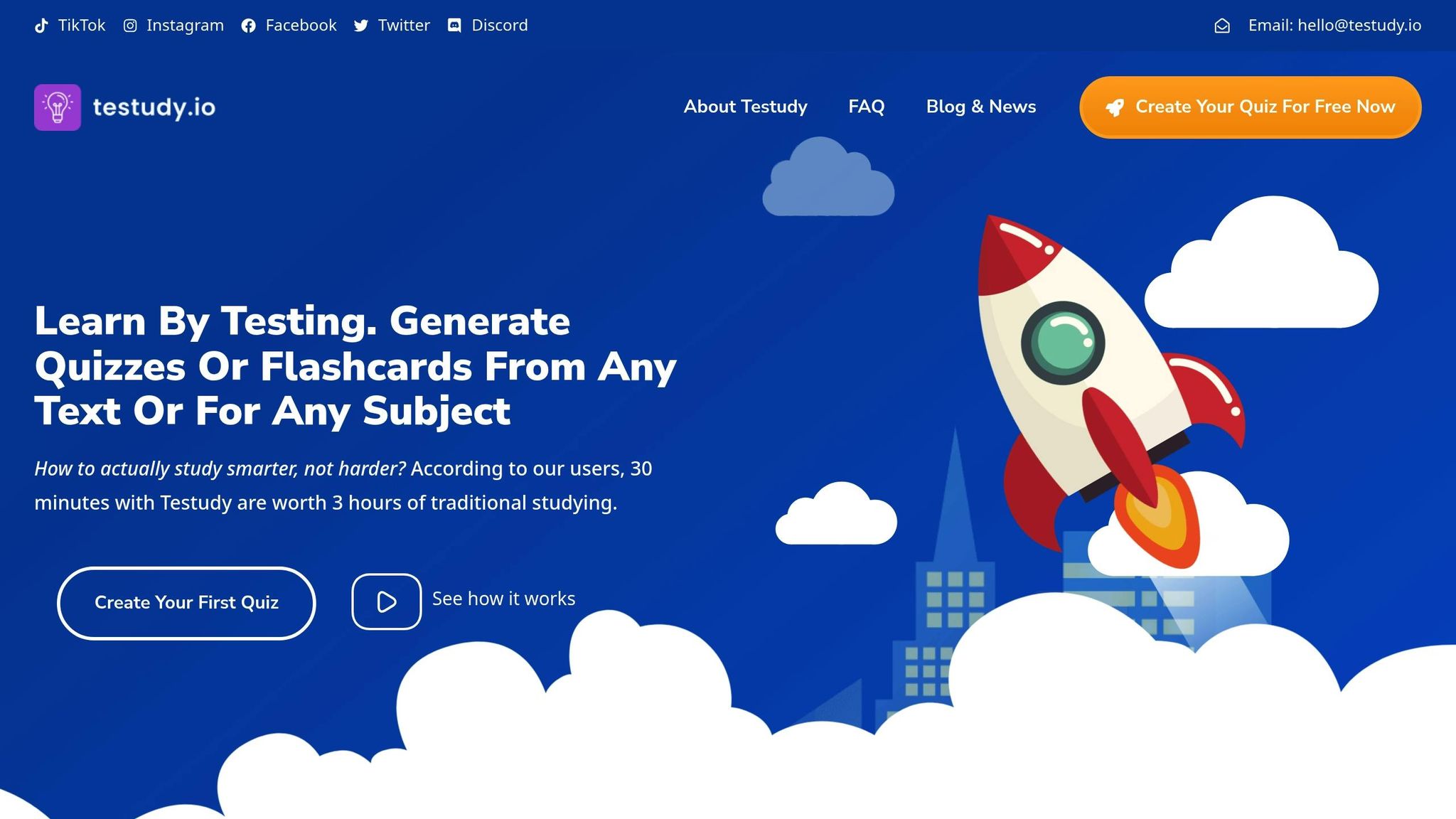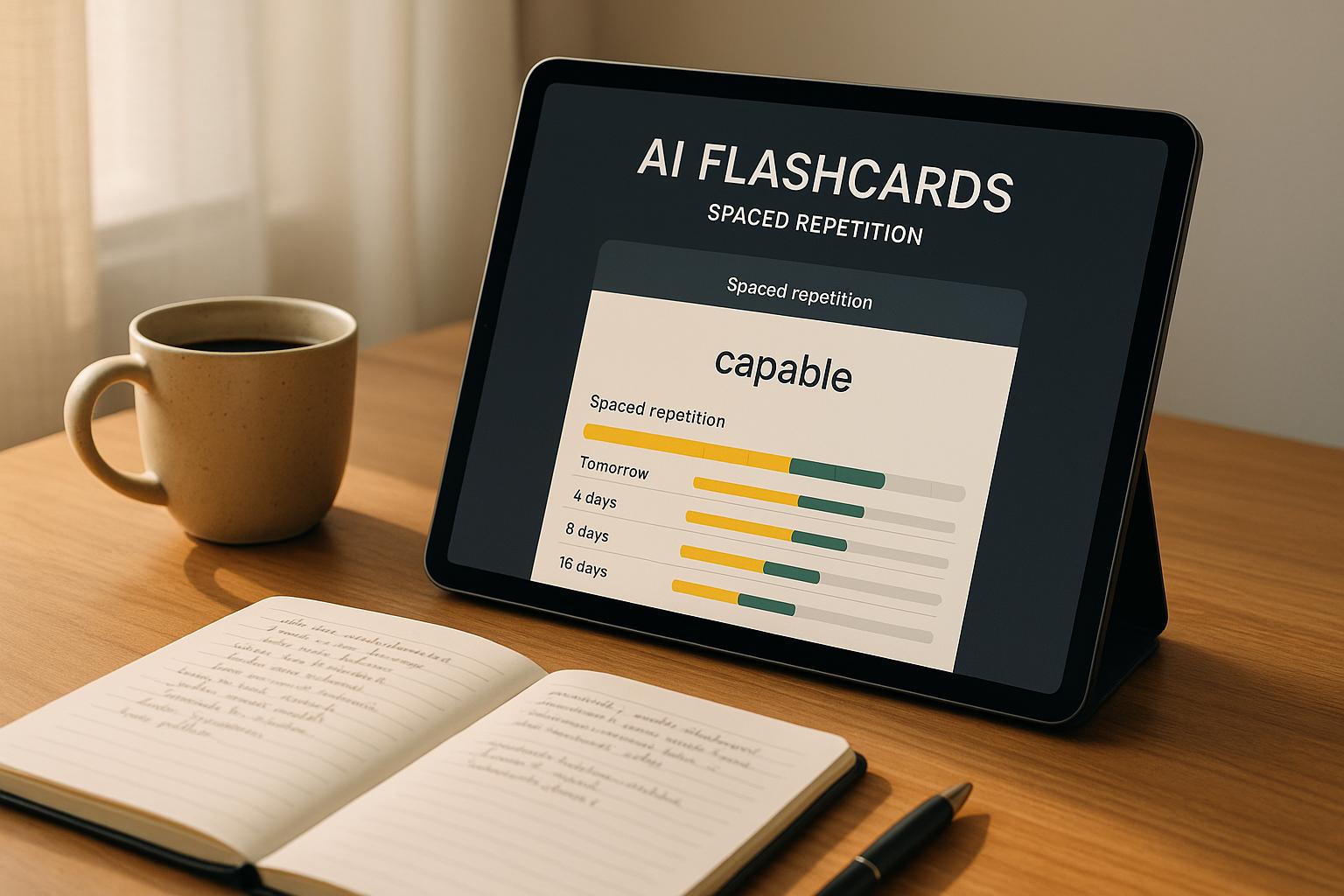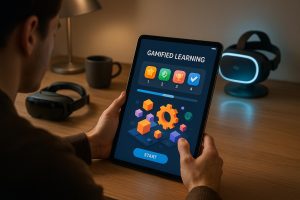Here’s the quick breakdown:
- AI flashcards adapt to your learning pace, focusing on what you struggle to remember.
- Spaced repetition strengthens memory by reviewing information at intervals just before you forget it.
- Together, they create a study method that boosts retention and saves time.
Key Benefits:
- Retain up to 80% of material compared to 34% with passive study methods.
- Cut study time by 30–50% with AI-optimized schedules.
- Learn smarter with personalized flashcards that adjust in real-time.
Tools like Testudy.io make this process simple by generating flashcards from your notes, scheduling reviews, and tracking your progress. Whether you’re a student or self-learner, this approach helps build long-term memory efficiently.
Keep reading to learn how it works and why it’s so effective.
The Science Behind Spaced Repetition
The Forgetting Curve and Memory Decay
In the 1880s, Hermann Ebbinghaus made an eye-opening discovery about how our memory works. Through experiments on himself, he observed that we forget about 50% of newly learned information within 30 minutes and up to 70-80% within 24 hours. This phenomenon, which he called "the curve of forgetting", reveals just how quickly information fades unless we actively work to retain it.
The forgetting curve shows how our memory weakens over time when we don’t review what we’ve learned. Without reinforcement, most people lose about 90% of new information after just seven days. While this memory decay is a natural way for our brains to filter out unnecessary information, it poses a challenge when we need to retain important material. That’s where spaced repetition comes into play. By revisiting information at carefully timed intervals, this method helps "catch" knowledge before it slips away.
"The goal of spaced repetition is to re-visit that new material when it is foggy but not completely forgotten." – The Bubbly Professor
Timing is everything. Each time you review, the brain strengthens its hold on the material, allowing for longer gaps between future reviews. This gradual adjustment is why spaced repetition is so effective – it aligns perfectly with how our memory naturally works.
How Repeated Recall Strengthens Memory
Every time you recall information, you’re doing more than just remembering – you’re reinforcing the neural pathways that store it. This process, known as repeated recall, makes it easier to retrieve the information later. Essentially, the more you practice recalling something, the stronger and more accessible that memory becomes.
Spaced repetition takes advantage of this by reintroducing material at just the right moment – when it’s challenging to recall but not yet forgotten. This slight difficulty in retrieval is key. Struggling a bit to remember something strengthens memory pathways far more effectively than simply reviewing material you already know well.
The results are hard to ignore. Research published in the Journal of Experimental Psychology found that participants using spaced repetition achieved an 80% recall accuracy, compared to just 60% for those who crammed. Another study in Memory & Cognition confirmed similar results, with spaced repetition outperforming other methods and participants achieving an average recall accuracy of 75%.
Medical students, who often face intense learning demands, have also seen major benefits. In one study from the Journal of Medical Education, students using spaced repetition scored an average of 88% on anatomy tests, compared to 78% for those who didn’t use the method. At the University of Leicester, students following a spaced repetition schedule achieved the highest adjusted mean exam scores (70%) among all study groups.
"Perhaps the most important discoveries are those which relate to the appropriate distribution of the periods of study… Review sessions should be spaced in gradually increasing intervals, roughly intervals of one day, two days, four days, eight days, and so on." – C. A. Mace, Author, Psychology of Study
These findings highlight why spaced repetition is far more effective than traditional study methods.
Spaced Practice vs. Cramming
The difference between spaced practice and cramming goes beyond timing – it’s about how the brain processes and stores information. Cramming focuses on short-term memory, while spaced practice builds long-term memory. This distinction is crucial because only long-term memory allows you to retain knowledge for weeks, months, or even years.
The effectiveness gap is striking. Studies show that spaced repetition is 89% more effective than cramming, with long-term retention improving by as much as 200% compared to single, intensive study sessions. Think of it like this: spaced repetition is equivalent to two solid learning events, while cramming might barely add up to one.
| Cramming | Spaced Practice |
|---|---|
| Relies on short-term memory | Builds long-term memory |
| Information quickly forgotten | Strengthens neural pathways |
| Causes stress and poor habits | Enhances recall and understanding |
| Reduces overall study time |
Cramming might feel effective in the moment, but it overloads your short-term memory, preventing proper long-term retention. Spaced repetition, on the other hand, works with your brain’s natural processes, reinforcing learning at just the right time to make memories stick.
"Work involving higher mental functions, such as analysis and synthesis, needs to be spaced out to allow new neural connections to solidify. New learning drives out old learning when insufficient time intervenes." – Pierce J. Howard
The efficiency of spaced repetition is undeniable. Language learning expert Gabriel Wyner explains: "Spaced repetition… [is] extraordinarily efficient. In a four-month period, practicing for 30 minutes a day, you can expect to learn and retain 3,600 flashcards with 90 to 95 percent accuracy."
Without review, you risk losing up to 90% of what you’ve learned in just a week. But by spacing out your study sessions, you can maintain high retention rates while actually spending less total time studying. This is why AI-powered tools that incorporate spaced repetition are so effective – they handle the timing for you, so you can focus on learning.
How AI Powers Spaced Repetition in Flashcards
Spaced repetition has long been celebrated for its ability to boost memory retention, but AI takes this concept to a whole new level. By analyzing your unique learning habits, AI doesn’t just follow fixed intervals – it adapts to your needs in real time. This creates a study experience that’s tailored specifically to you.
AI-Driven Study Scheduling
AI algorithms craft personalized study plans by examining factors like how quickly you respond, your accuracy, and the complexity of the material you’re studying. These systems dig deeper than traditional methods, considering hesitation, the context of your responses, and how different pieces of information are connected. They also model various memory types to predict the perfect moment for you to revisit each flashcard.
What makes this even more impressive is how AI adapts to your schedule. It takes into account practical constraints like how much time you have to study, your preferred study hours, and even upcoming deadlines. For instance, if you’ve got a test looming, the system will prioritize the material you’re most likely to forget, ensuring you focus on what matters most.
"The spacing effect is one of the most robust findings in the history of experimental psychology. The problem isn’t that spaced repetition doesn’t work – it’s that implementing it optimally is incredibly complex without computational assistance."
- Dr. Robert Bjork, Distinguished Professor of Psychology, UCLA
The impact is undeniable. AI-optimized spaced repetition can cut study time by 30–50% while maintaining – or even improving – retention rates. For example, students using these systems retained 92% of the material after six months, compared to just 23% with traditional study methods.
Beyond scheduling, AI also refines how often you review material by evaluating the difficulty of each flashcard.
Automatic Difficulty Assessment
AI doesn’t just manage when you study – it also determines how challenging each flashcard is. By analyzing your recall accuracy and how quickly you respond, it identifies which cards need more frequent review and which can be spaced out. It even spots patterns in the material you tend to forget and provides extra reinforcement in those areas. This means you focus on the concepts that challenge you the most, rather than wasting time on a generic schedule.
Different systems approach this in various ways. Some use "absolute" algorithms to set specific times for review based on your confidence ratings, while others use "relative" algorithms that adjust repetition likelihood based on comparative confidence levels.
| Traditional Scheduling | AI-Powered Scheduling |
|---|---|
| Fixed algorithms | Real-time AI adjustments |
| Basic difficulty tweaks | In-depth learning analysis |
| Right/wrong tracking | Detailed, real-time insights |
| Manual content creation | AI-assisted creation |
Data adapted from [14].
Take Julia, for example – a medical student tackling anatomy. With an AI-powered system, her flashcards were not only created efficiently but also scheduled based on her unique forgetting curve. The result? Her grades jumped from a B– to an A, and months later, she still remembered the material.
The advantages go beyond test scores. Personalized spacing algorithms improve retention by 35% compared to fixed schedules, while targeted reinforcement of weaker areas boosts overall performance by 28%. Students using AI systems also score 35% higher on questions that require combining multiple concepts, proving these tools enhance understanding as well as memory. And by reducing the mental load of managing a study plan, AI systems cut study-related stress and anxiety by 40%, allowing you to focus entirely on learning.
"AI-optimized spaced repetition represents one of the most significant advances in educational technology of the last decade. By creating truly personalized review schedules based on individual cognitive patterns, these systems are achieving retention rates we previously thought impossible outside of exceptional learners."
- Dr. James Liu, Cognitive Science Research Director, Stanford University
sbb-itb-3165b23
Using Testudy.io for AI Flashcards and Spaced Repetition

Testudy.io blends AI-powered flashcard creation with adaptive spaced repetition to make studying more efficient. This platform converts text, documents, or subjects into personalized study tools, letting you focus on learning instead of spending hours crafting flashcards. Let’s dive into what makes it stand out.
Key Features of Testudy.io
With Testudy.io, you can upload PDFs, presentations, notes, or even images to instantly generate flashcards in over 20 languages. The AI scans your materials, identifies key concepts, and automatically creates question-and-answer flashcards, removing the need for manual effort. Plus, using its Chrome extension, you can turn webpages into study materials on the fly. If you want to tweak or improve the cards, the platform’s user-friendly interface makes it easy to customize them anytime.
One of the standout features is complete customization control. After the AI generates your flashcards, you can edit, add, or refine them to suit your learning goals. This flexibility ensures that your study materials align perfectly with your specific needs.
Another helpful tool is the progress tracker, which highlights areas you’ve mastered and those that need more attention. This feature provides valuable insights into your performance, helping you stay on top of your studies.
How Testudy.io Uses Spaced Repetition
Testudy.io personalizes review schedules based on how well you perform. If you’re confident in a topic, the system spaces out reviews over longer intervals. For trickier concepts, it schedules more frequent reviews to reinforce your understanding. By tailoring these intervals to your progress, the platform adapts to different learning styles.
The system also incorporates active recall, which encourages you to test yourself rather than passively review material. This approach strengthens memory retention and helps pinpoint areas where you might need extra practice. The AI tracks your recall accuracy and adjusts the review schedule to keep your learning on track. These strategies work together to enhance your study routine.
Benefits for Students and Self-Learners
Using Testudy.io’s AI-enhanced spaced repetition takes the hassle out of studying while boosting memory retention.
The platform saves you time by automating flashcard creation and review scheduling. Instead of manually writing cards, you can generate entire sets in seconds. This not only reduces stress but also improves learning efficiency. Testudy.io supports various formats and offers flexible pricing plans to suit different needs.
For those on a budget, the free plan allows up to 3 flashcard sets with 25 AI generations. For more extensive use, the Semester plan costs $20.99/month, while the Term plan is $13.09/month, both offering unlimited flashcards and AI generations.
Testudy.io is especially helpful for students who struggle with staying organized or consistent. By automating key tasks like flashcard creation and review scheduling, it removes common obstacles to effective studying. This allows learners to focus on building strong, sustainable study habits without unnecessary stress.
Getting the Most from AI Flashcards
AI flashcards are more than just a tool – they’re a dynamic way to tailor your learning experience. By combining AI-powered scheduling with personalized adjustments, you can fine-tune your sessions to improve retention and understanding.
Customizing Your Study Sessions
To make the most of your study time, focus on your weaker areas and adjust the content to meet your needs. Instead of relying solely on the AI’s initial suggestions, take charge of the material to ensure it aligns with your goals.
Break down large documents into smaller, focused sections to create targeted flashcards. Research suggests that dividing content this way enhances the relevance of your flashcards and helps you zero in on specific topics.
Fine-tune AI-generated questions to suit your learning style. For example, you can simplify overly broad questions, add detailed notes, or adjust the difficulty. If you’re struggling with a particular topic, make those flashcards more detailed. On the other hand, simplify material you’ve already mastered.
Organize your flashcards by categories, such as topics or difficulty levels, and use tags to group related cards. This structure makes it easier to focus your study sessions on areas that need extra attention.
"Users can refine revision flashcards using AI prompts, ensuring tailored content that aligns perfectly with their study goals and preferred learning style." – Algor Education
Don’t forget to provide feedback to the AI. Many platforms improve with user input, so the more you interact and refine, the better the system gets at creating flashcards that match your preferences.
To take your learning a step further, enhance your flashcards with multimedia elements.
Adding Images and Audio to Flashcards
Incorporating images and audio into your flashcards can transform them into powerful learning tools. Studies show that flashcards with multimedia elements boost recall by 208% after a month compared to text-only methods. Weekly retention rates also soar to 80% with multimedia, compared to just 34% with traditional approaches.
This happens because multimedia engages multiple parts of the brain. For example, audio activates areas linked to emotional and contextual memory, while visuals stimulate the brain’s visual processing centers.
Here’s how to use different media effectively:
| Media Type | Best For | Memory Boost |
|---|---|---|
| Images | Complex ideas, diagrams, anatomy visuals | Improves visual memory |
| Audio | Language pronunciation, music theory, speeches | Enhances auditory recall |
| Video | Physical tasks, dynamic processes | Combines visual and auditory learning |
For language learning, include audio for pronunciation practice and consider adding International Phonetic Alphabet (IPA) transcriptions to ensure accuracy. For technical subjects like anatomy or chemistry, use diagrams and charts to simplify complex ideas.
"The way we formulate knowledge in learning has a monumental impact on memory. Thoughtfully crafted questions simplify learning, while well-organized knowledge ensures it stays with you for a lifetime." – Dr. Piotr Wozniak
The trick is to match the media type to the subject. Visual learners may find charts and infographics most helpful, while auditory learners should focus on sound clips and spoken explanations.
Once your flashcards are optimized, track your progress to continuously refine your study methods.
Monitoring Progress and Adjusting Methods
AI platforms often track your learning patterns, such as which cards you struggle with, how frequently you review them, and your overall accuracy. Use this data to guide your study strategy.
Regularly review your progress. If you notice certain topics are consistently challenging, increase the review frequency for those flashcards or break them into smaller, digestible pieces. While the AI adjusts difficulty levels based on your performance, you can also fine-tune these settings manually.
Pay attention to review intervals. If you’re consistently answering a card correctly, space it out further. For tougher material, decrease the interval until you’ve mastered it.
"Phrasing your flashcards as questions means that your mind works harder to get the answer. It eliminates the chance that your brain is just associating recognition with actual knowledge." – Think Student
Prioritize challenging cards at the start of each session, but mix up the order during reviews to prevent your brain from relying on patterns. This approach builds genuine understanding rather than simple memorization.
Effective learning requires constant adjustments. Different subjects may demand different strategies, so remain flexible and let your performance data guide your approach. With these methods, you’ll be well on your way to mastering your study material.
The Future of Learning with AI and Spaced Repetition
Education is moving away from cookie-cutter models and embracing highly personalized learning experiences tailored to each student’s unique needs and habits.
Recent data highlights how fast this shift is happening. In 2023, UNESCO revealed that 63% of educational institutions worldwide had adopted some form of AI technology. This surge in adoption was largely fueled by the pandemic’s push toward digital solutions. The market reflects this momentum: projections show the personalized learning sector reaching $7.8 billion by 2025, with the AI-driven immersive learning market expected to climb to $12.6 billion by 2027.
"The integration of AI with established memory science represents one of the most significant advances in learning technology of the past decade. By personalizing the forgetting curve for each student, these systems achieve retention rates that traditional methods simply cannot match." – Dr. Robert Martinez, Cognitive Neuroscientist, Johns Hopkins University
The results speak for themselves. Arizona State University has rolled out one of the most comprehensive adaptive learning platforms in higher education, benefiting over 65,000 students. Their system collects around 500 data points per student per course, analyzing factors like time spent on concepts and response styles. This approach has led to a 28% drop in course failure rates and a 12% increase in completion rates for math and science courses.
AI is also reshaping spaced repetition and memory retention. Multimodal learning analytics now combine data from text, voice, and even facial expressions to build deeper insights into how students learn. Meanwhile, AI-powered immersive learning tools are blending artificial intelligence with virtual and augmented reality to create lifelike simulations.
Platforms like Testudy.io are leading this charge in AI-driven spaced repetition. With a 97% satisfaction rate, students report that just 30 minutes on the platform delivers the same results as three hours of traditional studying . Testudy.io’s ability to transform any text or document into flashcards and quizzes in over 20 languages is making effective learning strategies accessible to a much broader audience.
Predictive analytics are also becoming more advanced. For example, Duolingo’s "half-life regression" algorithm predicts how quickly users forget specific vocabulary and schedules review sessions at just the right time. This method improves long-term retention by about 34% compared to static review schedules. It’s a major step forward from traditional flashcard routines.
Looking ahead, AI-driven learning systems will become even more attuned to individual needs, adapting to learning patterns, emotional states, and preferred study times. Gamification elements will make these tools more engaging, while still maintaining the scientific rigor that makes spaced repetition so effective. As these technologies evolve, they’ll open up new opportunities for improving memory retention and accelerating learning across all levels of education.
FAQs
How do AI-powered flashcards decide when to review material?
AI-powered flashcards leverage advanced algorithms to optimize your study sessions by pinpointing the ideal times for review. These systems track details like how often you get answers right, your confidence in those answers, and how long you spend on each question. Using this data, the AI predicts when you’re most likely to forget a concept.
This approach, called spaced repetition, spaces out reviews in a way that reinforces your memory over time. What’s even better? The AI tailors these review intervals to fit your personal learning habits, helping you study smarter, not harder.
What makes AI-powered flashcards better than traditional ones for studying?
AI-powered flashcards bring a fresh twist to studying, offering a smarter way to learn compared to traditional ones. With the help of spaced repetition algorithms, they ensure you’re reviewing material at just the right times. This boosts how well you remember things over the long term and helps you focus on areas where you need the most improvement – saving both time and energy.
What makes them stand out even more is their ability to adjust to your personal learning style. These flashcards dynamically adapt to your strengths and weaknesses, creating a study plan that’s tailored just for you. Unlike static traditional flashcards, this personalized approach makes studying more efficient and productive, helping you zero in on what matters most.
Can AI flashcards be tailored to fit different learning styles?
AI flashcards are designed to align with different learning styles and preferences. Thanks to adaptive learning algorithms, these tools can adjust both the content and review schedule based on your performance. This way, they help you concentrate on areas where you need extra practice.
What’s more, many AI-powered flashcards offer a range of formats, including text-based cards, quizzes, and even audio-enhanced options. This flexibility makes them suitable for visual, auditory, or kinesthetic learners, ensuring a study experience that feels personalized and effective.




